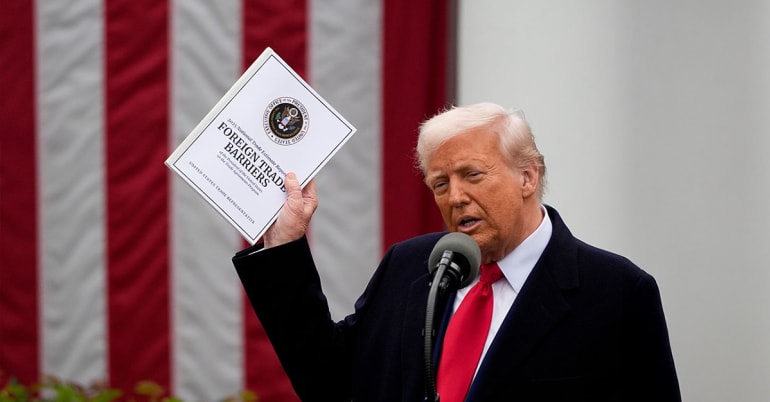Recently, Steve Sedgwick, one of Squawk Box Europe's hosts on CNBC and an influential voice for market observers, encouraged viewers to listen to a speech by Ronald Reagan, the former US president. During a 1985 address regarding trade negotiations between the US and Canada and their tariff barriers, Reagan told his compatriots that manufacturing employment had improved since the US decided to lower its tariffs.
Republican in heart and broadly in programme, Reagan had to face the consequences of a Federal Reserve (Fed) standing tall to end the rampant inflation of the 1970s, plunging the US economy into a double recession. Yet, Reagan held firm, encouraging trade with partners, while also negotiating the Plaza Accord to relieve the US dollar's high value.
The similarities to the current situation are striking, from the US trade deficit to the signs of a US economic slowdown and the strong dollar. The current Trump administration is making a radically different choice, however, opting for protectionism over trade liberalism. Was Reagan correct to say that industrial employment in the US had benefited from lower tariffs? This issue of Simply put examines the data to find out.
Read also: What Liberation Day's reciprocal tariffs mean for investor
Manufacturing employment: from rise to decline
Thanks to a historic statistical tradition, the US has a long annual economic series, particularly regarding employment. Figure 1 shows the evolution of the number of people employed in the US manufacturing sector since 1900. Each point represents a year. While manufacturing employment increased from 6 million people to just under 13 million people over the entire period, two periods are distinct:
- 1900 to 1980, when manufacturing employment reached 19 million people, from a total population that increased from 76 million to 220 million inhabitants. The manufacturing workforce thus increased by 216% over the period compared to 190% for the country's population: during this period, the manufacturing workforce grew faster than the American population itself
- 1981 to 2025, when manufacturing employment declined, falling from 19 to 13 million jobs, while the total population gained some 109 million. Here, the manufacturing sector showed a clear decline in both absolute and relative terms.
Blaming free trade for this break in industrial employment dynamics is probably excessive: the US hasn't significantly modified its tariffs since the early 1950s. What about the earlier period? Was there an observed link between tariff fluctuations and manufacturing employment?
FIG 1. Evolution of US manufacturing employment (in thousands) since 1900 and US recessions1
Read also: Multi asset: investing in a period of tariff-induced uncertainty
Free trade is not the enemy of manufacturing employment
Rejecting an economic intuition is always easier than proving one. A simple way to verify if increasing tariffs protects and stimulates manufacturing employment is to represent employment as a function of tariff levels in the US. This is shown in Figure 2, which compares absolute employment values and tariffs on the left and manufacturing employment as a ratio of the US population on the right. Indeed, if the population grows and a constant fraction finds employment in the manufacturing sector, then the number of jobs increases simply due to population growth. These graphs also distinguish between the two periods mentioned above: 1900-1980 and 1981-2024. The conclusion from these graphs is quite clear:
- US manufacturing employment has historically been lower during periods of high tariffs, especially during the 1900-1980 period
- The conclusion holds for this sub-period both in absolute terms and as a ratio of the total population.
FIG 2. US manufacturing employment vs average US tariffs2
Obviously, the next question is probably what concerned Ronald Reagan in 1985: why has manufacturing employment ceased to grow in the US since 1980? If tariffs don't appear to explain this phenomenon, what factors should be considered? Probably the industrialisation of Japan and then China; but this also enabled the emergence of a service society in the US as well as a rise in the purchasing power of the average American household. If tariffs are not responsible for the deterioration in manufacturing jobs, increasing them may have unexpected consequences: this is one of the dangers we face in the coming period of industrial transition.
The period ahead of economic uncertainty will influence financial markets, particularly regarding the valuation of cyclical assets. In this context, the diversification of market exposures in a portfolio seems essential to us. In our All Roads strategy, a 55% exposure to protective assets (mainly bonds and volatility), as well as our overlays, constitute an effective first line of defence, allowing us to remain invested in markets that are currently turbulent.
Simply put, the rise of free trade doesn't appear to coincide with a deterioration in manufacturing employment – its degradation is likely due to other factors.
To learn more about our All Roads multi-asset strategy, click here.
Macro/nowcasting corner
The most recent evolution of our proprietary nowcasting indicators for global growth, global inflation surprises, and global monetary policy surprises is designed to track the recent progression of macroeconomic factors driving the markets.
Our nowcasting indicators currently show:
- With the recently softer streak of economic data, our growth nowcasting signal currently shows 46% of improving data (this number was well above 50% in December)
- Our inflation indicator shows rising pressures in the eurozone, remains stable in the US and is declining in China
- Our global monetary policy indicator showed an interesting decline in the eurozone this week that could open the door to a more dovish-than-expected European Central Bank policy in the months to come.
World growth nowcaster: long-term (left) and recent evolution (right)
World inflation nowcaster: long-term (left) and recent evolution (right)
World monetary policy nowcaster: long-term (left) and recent evolution (right)
Reading note: LOIM’s nowcasting indicator gathers economic indicators in a point-in-time manner in order to measure the likelihood of a given macro risk – growth, inflation surprises and monetary policy surprises. The nowcaster varies between 0% (low growth, low inflation surprises and dovish monetary policy) and 100% (the high growth, high inflation surprises and hawkish monetary policy).










